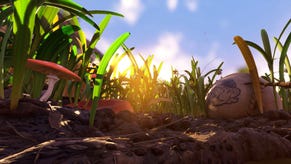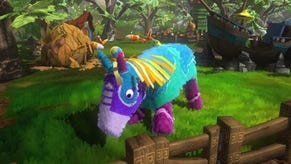A Rare pleasure
Eurogamer tours Rare, and delves into Viva Pinata's development.
According to Justin Cook, Viva Pinata's designer, they were just mucking about. "It's not a personal attack," he says, stifling a laugh. "It's just something funny that was happening at the time and, well, we thought..."
They thought they should include a load-screen that said, 'Use the d-pad for real-time tool-change and wallop Seedos' weak spot for massive seedage!'
It's an impersonal attack that's sure to see Genji's widely mocked 'giant enemy crab' - accidental star of Sony's E3 2006 press conference - rolling over in its grave (after all, that's how you attack its weak spot in the first place). "We certainly bear no ill will toward anybody," says Cook, who's given up stifling and settled into a grin. "We just thought it was funny."
Gardening Angels
Cook's quite relaxed. So's everyone, in fact. Lee Schuneman and Steve Brand guide us around Rare's Twycross studio, happily stopping to tell us about the giant banner in the lobby, which Nintendo bought them, rather than endlessly droning on about the game. The staff in the "barn" - Viva Pinata's home studio - admit to spending much of their time at the moment reading forums to see what the reaction's like, and seem happy to stand around chatting with me about the PS3 and Wii launches. Production staffer Chris Sutherland (lead programmer on Donkey Kong Country, doncha know) has enough time to show me the "style guide" that Rare's TV show partner 4Kids has produced to help people get the pinata to look right in magazines and promotional items. Musician Grant Kirkhope keeps us entertained for ages, walking us through the difference between the synthesised music he produced and the Prague philharmonic efforts that went into the game (he also has an excellent habit of talking about something and then asking the others if he's allowed to). Even higher-ups Simon Farmer and Gregg Mayles, who decline to be photographed when we talk to them ("we're not popstars"), sink happily into the sofa and address us with the confidence of men who've been surveying a critical landscape cluttered with mountainous superlatives.

They're relaxed because Viva Pinata is finished (it's out in the US, and due out on 1st December in Europe). They're relaxed because it's been scoring very well (I gave it 8/10, as have quite a few other people). They're relaxed because people seem to be getting what it is ("a subtle blend of resource management and Origin of Species" and "a welcome return to form", if you ask me, and not just the 'kids game' some have billed it as). And they're relaxed because, even though our tour of their home is being chaperoned by Microsoft, they're not feeling the weight of the record-breaking $375 million the Xbox giant paid for them in 2002. Like the gamer who plays Viva Pinata, Rare's operating under reasonable constraints - but they don't mind them, they're nothing sinister, and they don't spoil the fun. It's still their garden.
Animal frame
Viva Pinata first came about in 2002 and not, as you might perhaps expect, because Microsoft got on the blower one day and said, 'make a game for kids'. "We wanted to do something fresh," says Cook. "The original idea I had actually came from Tim Stamper - he wrote a little design document, I was just being moved up from testing, I was passed the design document and then kind of set off with a little team to see if we could make the idea work." That team of three people was given a year to make Stamper's "Your Garden" idea into something worthy of full production. "We were working on a PocketPC at the time, because that was the only platform that had regular Internet access and we wanted the trading aspect of the game - that was kind of important."

The broader theme was that you had a garden to customise and share, but you weren't in control of the animals that made their home there - something that remains the case in the final game. "All the way along we wanted the animals to be spontaneous and wild," says Cook, "so they come in and do what they want to do in your garden - that atmosphere almost makes stories when you're playing the game. Things go through your head - 'he's doing that on purpose! He's just taken a dislike to me, and he's doing this and that and the other.'" In the final game, you can rename animals, customise them (with dustbin lid hats if you like) and 'direct' them to go to certain places, but it's up to them whether they follow orders. They still cause mischief.

And contrary to popular myth, the game didn't start off with pinatas in it at all. "We just had animals to start with, but we wanted a unique look and we wanted something brand new we hadn't seen before. Our concept artist, Ryan Stevenson, came up with the pinata idea because it was a unifying theme," says Cook. "But once we'd got those pinatas, that then fed into the gameplay, and changed the game." In the final version, for example, 'sour' pinatas spill evil red sweets onto the lawn, in the manner that real pinata do when kids whack them at parties, and friendly pinata fall ill if they eat one of the sour sweets, necessitating an expensive visit from the doctor, and forcing you to deal with the threat of intruders before everything goes to, er, rot.
The pinata style also gave the game a very fetching aesthetic, but at a cost. Even when Microsoft came along with its first Xbox platform, it was tough work getting that ruffly paper skin - evolved from the fur effect Rare's spent many years perfecting, and very processor intensive - to work throughout the garden. "Before we swapped to Xbox we ported the game over to PC, but we had some difficulties because we loved the graphics and we didn't want to compromise them," says Cook. "We were going to do it on the Xbox originally, but you could choose one pinata and have that effect on it and then the others would just be smooth. When we reached the 360 they could all have it and we all went 'eeeeeeeeeee!'" (A good noise, for the record.)















.png?width=291&height=164&fit=crop&quality=80&format=jpg&auto=webp)
